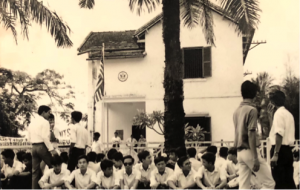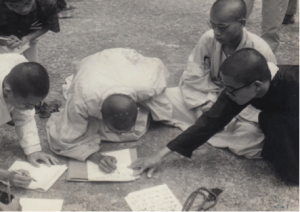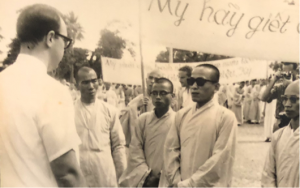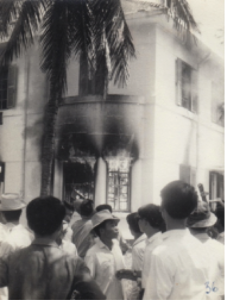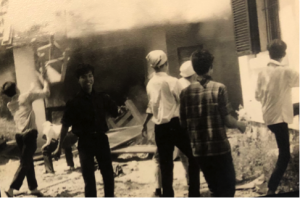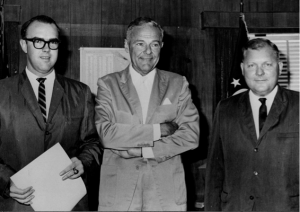by James R. Bullington
My first overseas post as a newly-minted Foreign Service Officer was the American Consulate at Hué. I arrived in July, 1965, just as the massive deployment of U.S. combat units was getting underway. Emerging from a redneck hillbilly background in Tennessee and Alabama, and devoid of any international experience, I could not imagine the challenging, life-shaping adventure on which I was about to embark. This is my Foreign Service war story/love story/coming-of-professional-age story, as well as a participant’s account of a significant but largely unknown episode in the history of the Vietnam War.
In 1965, the Vietnam War had not yet come to dominate American politics as it did by 1967. Nonetheless, it was very much in the news, and I was happy to be going to an exciting job in an exotic country that was emerging as a major focus of American foreign policy. Moreover, I had been unable to achieve my childhood dream of a military career because of a teenage bout with polio that left me with a slightly crippled leg, so I was pleased to have this opportunity to serve my country in a war. I was 24, and more than a little naïve.
The Consulate in Hué
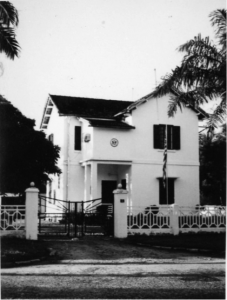
Despite the worsening security situation in the countryside, Hué had remained free from Viet Cong attacks, and it was a pleasant place to live. As Vietnam’s pre-colonial capital, it was historic, exotic, and attractive, with an impressive old walled city, the royal palace, elaborate tombs of emperors, and peaceful pagodas. Even though its days of imperial splendor were long past, it remained a major cultural, religious, and educational center, as well as South Vietnam’s third largest city (after Saigon and Danang), with about 100,000 people.
The Hué Consulate was a “special purpose post,” created to help the Embassy monitor the five northernmost provinces of South Vietnam, known as I Corps. It was staffed by three Americans: a Consul, a Vice Consul (me), and a communicator/administrative support officer.
There were also three Vietnamese FSN [Foreign Service National] professional-level staff. I especially noticed our receptionist/translator, Tuy-Cam. She was an attractive and unmarried young woman, but at first I didn’t see her as a romantic possibility, because just before my departure for Vietnam I had become engaged to a woman in Washington. After she broke off the engagement in December, I saw Tuy-Cam in a new light, and our courtship began.
There were about a dozen other American government civilians in Hué, working for CIA, USAID [U.S. Agency for International Development], and USIA [U.S. Information Agency], along with about 200 American military advisors to the Vietnamese First Division and local security forces.
Deteriorating Security and Rising Political Tension
In the second half of 1965, even though the South Vietnamese and newly-arrived American combat forces were winning almost all the battles and inflicting heavy casualties, the communists, with an ever-growing flow of supplies and reinforcements from the North, were gradually increasing their control in rural areas. Refugees were becoming more numerous, and attacks on bridges and other infrastructure were disrupting the economy. Moreover, after a period of relative calm, internal political tensions were rising by early 1966, especially in Hué and Danang. The opposition to the still-military government of President Nguyen Van Thieu and Prime Minister Nguyen Cao Ky was led by Thich Tri Quang, a charismatic young monk who had also been a leader in the uprising that led to the 1963 overthrow of President Diem. He directed the radical wing of the Buddhist political movement, based mostly in the I Corps region, and was politically allied with the I Corps commander in Danang, Lt. Gen. Nguyen Chanh Thi.
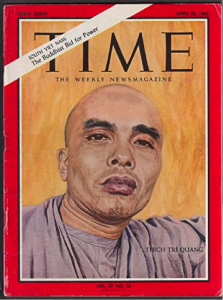
Due to transfers and staffing gaps, beginning in January 1966 there was no Consul in Hué, and I was left in charge of the post until late May. This was a heavy responsibility for a young FSO-7 (comparable to a first lieutenant in the military). I was reporting from the focal point of what was rapidly becoming a major crisis for South Vietnam and for U.S. Vietnam policy. I dealt directly with the principal opposition leader, Thich Tri Quang, as well as with senior government officials and military commanders, many of whom were participants in what became known as the “Buddhist Struggle Movement.”
The Struggle drew heavy press and TV coverage in the United States and raised deep concerns at the White House, State Department, and Pentagon, because it disrupted the war effort, threatened a return to the political chaos of 1963-64, and raised questions about the Johnson Administration’s Vietnam policy.
Beyond replacement of President Thieu and Prime Minister Ky with new leaders who would organize an election and return to civilian government, the movement’s political objectives were unclear. It was not pro-communist, although the political turmoil it created was clearly harmful to the government’s ability to prosecute the war.
The Struggle became more intense with the dismissal on March 10 of the I Corps commander, Lt. Gen. Thi. He was an effective and popular general, but he had been well on his way to establishing himself as a warlord, defying direct orders from the central government. His removal set off massive demonstrations and strikes throughout the region.
By the end of March 1966, the Viet Cong had infiltrated the Struggle, and it became increasingly anti-American. Ominously, large numbers of soldiers, policemen, and civil servants were joining anti-government demonstrations in Hué and Danang.
On April 6, the Embassy decided to evacuate all “non-essential” U.S. Government civilians from I Corps and advised all private citizens to leave. Bob Shaplen, one of the most perceptive American reporters covering the war, wrote in The New Yorker on April 16, “In many years here, I have never seen the morale of both the South Vietnamese and the Americans descend so close to a state of panic.”
In this situation, my almost-daily reports from Hué to the Embassy received lots of attention, and most were forwarded directly to Washington. Some were read by, or at least summarized for, Secretary of State Dean Rusk and other top-level officials. An example was the cable I wrote the night of May 17, recounting the extraordinary events of that day.

A Most Dramatic Day in May
The newly-appointed I Corps commander, Maj. Gen. Huynh Van Cao, had scheduled his initial visit to the First Division on the morning of May 17. I went to Division headquarters for the ceremony, together with the senior American advisors. Of the entire Division staff, only six officers, the highest ranking of whom was a major, turned out to welcome their new Corps commander. The rest, including the Division commander, refused to appear. At the conclusion of the abbreviated ceremony, Gen. Cao and his American advisors hurried to their waiting U.S. helicopter. As the helicopter lifted off the ground, a lieutenant began firing at it with his rifle. The American door gunner returned fire, killing the lieutenant and two other First Division soldiers. It was later established that this was part of a poorly executed plot to assassinate Maj. Gen. Cao.
After witnessing these events, I got in the Consulate Plymouth sedan with a U.S. flag on the fender to drive back to the office. A few hundred yards outside the First Division compound I encountered a mob of more than a thousand students, who had been holding a demonstration downtown. They had been informed of Gen. Cao’s visit and were on their way to Division headquarters to confront him. The mob filled the street, and I had to stop the car and sit there for 15-20 minutes as they passed by, beating on the car and shouting “Down with America.” They tried to open the locked car, but couldn’t break the bullet-proof windows.
When the last of the demonstrators had passed, I picked up Tuy-Cam at the Consulate to accompany me for an appointment with Thich Tri Quang at his pagoda. He did not speak French, and I needed her to interpret. The previous week, he had sent a message through me to President Johnson, demanding that we oust President Thieu and Prime Minister Ky. (We found this ironic, since another demand of the Struggle was that Americans cease interfering in internal Vietnamese politics.) The purpose of my appointment was to deliver President Johnson’s response. My instructions in delivering it, as described to a New York Times correspondent, were: “Mr. Bullington has been told to be neither overly cordial nor overly cool and to tell Tri Quang that the United States hoped he and the Premier would be able to come to some understanding.”
By the time we reached the pagoda, Tri Quang had gotten word of the incident at First Division headquarters. According to his version, the American helicopter gunner, without provocation, had fired on and killed pro-Struggle soldiers. He was furious about this, rejected my eye-witness account that the Vietnamese lieutenant had fired first, and found it difficult to listen to my counsel of moderation.
Before our conversation came to an end, prolonged small arms fire broke out near the pagoda, and Tri Quang told Tuy-Cam and me to leave right away for our safety. We did so. A few hundred yards from the pagoda we were stopped at a roadblock manned by armed Buddhist students. They were agitated and pointed their weapons at us. After telling them we had just met with Thich Tri Quang to deliver a message from President Johnson, we persuaded them to let us pass. We later determined that the gunfire was between these students, who had been joined by some soldiers and policemen, and an armed militia group from a nearby Catholic neighborhood.
After returning to the Consulate, I wrote a lengthy cable reporting all this: the assassination attempt on the new I Corps commander, the massive student demonstration I had encountered, my meeting with Tri Quang to deliver the President’s message, and the Buddhist-Catholic firefight in the middle of Hué. It was the most interesting and widely read cable I ever wrote.
The Embassy realized that additional diplomatic representation was needed in Hué, and that a very junior officer on his first overseas assignment should no longer be left to handle the situation alone. Consequently, a few days later the deputy chief of the political section, Tom Corcoran, arrived to become Consul. Tom had spent a week in April on temporary duty in Hué, but now his assignment was to be permanent, or at least long-term. He was a senior officer with extensive Indochina experience. I welcomed Tom’s arrival, and he became a good friend and mentor.
Moreover, Tom brought with him a cable, addressed personally to me, from Secretary of State Dean Rusk. The text of the cable read:
It is always gratifying to me to learn that our young Foreign Service Officers have the courage to grasp the initiative and respond to situations with intelligence and alacrity. Congratulations to you and your colleagues for your performance in Hué during the period you were at the helm.
It is exceedingly rare for a junior FSO to receive a personal message of any kind from the Secretary of State. I was thrilled.
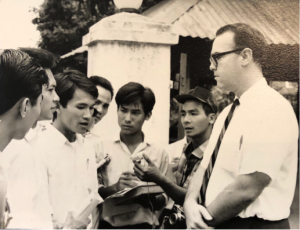
Burning the Consulate
There had been a lull in Struggle activities in mid-April, following a government-organized national political convention in Saigon that accepted some of the Struggle demands, including return to civilian government. At Tri Quang’s urging, demonstrations ceased for a time. However, moves by Struggle leaders to consolidate their power in I Corps, countered by government moves to re-assert its authority, soon re-ignited hostilities. In Hué, 2000 students were formed into a “Death Volunteers Association” and were given weapons by the First Division commander. (It was members of this group that Tuy-Cam and I encountered at the roadblock on May 17.) By early May, the region was again slipping into a state of open insurrection.
On May 15, the government airlifted 1500 elite paratroopers and Marines from the strategic reserve in Saigon to Danang. They quickly occupied most of the city, but Struggle fighters regrouped around two pagodas, and a standoff ensued. Tri Quang pictured this operation as an unprovoked attack on the Buddhist religion and a betrayal of the agreement to return to civilian government. With most of the First Division on their side, the Strugglers began preparations to defend Hué militarily.
In Danang, after unsuccessful efforts to negotiate the dissidents’ surrender, the Marines and paratroopers overran their positions following sharp fighting. The city was secured, government control was restored, and the Struggle in Danang collapsed.
These developments made the Strugglers in Hué even more hostile to the government and its American backers. Security deteriorated further, and large groups of students alternated with Buddhist monks and nuns in conducting daily demonstrations in front of the Consulate. At first these demonstrations were peaceful, but they progressed to making threats and throwing stones.
On May 26, a student mob attacked and burned the USIA cultural center and library. We evacuated all remaining American civilians in Hué except Tom Corcoran and me, communicator Maurice Brooks, and a couple of CIA officers. When this was accomplished, we all moved into the compound housing the American military advisors, from which we did what political reporting and intelligence gathering we could, even though movement about the city was dangerous and limited. We maintained contact with our loyal and courageous Vietnamese staff, especially Tuy-Cam and Joe Nghia, who provided vital information about the rapidly evolving situation.
On June 1, the Consulate was sacked and burned. As described by the Associated Press:
A mob of about 1000 screaming students attacked the two-story Consulate building just before noon, ripped down portraits of President Johnson and carried off two U.S. flags as the building burned.
The only casualties from the incident were several students who were injured by the explosion of some of our butane tanks (used for cooking) that were in a storage shed adjacent to the Consulate.
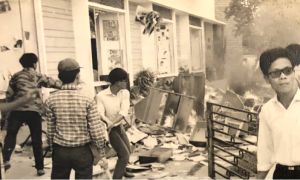
Government Control Restored
After the burning of the Consulate, the most militant Strugglers continued demonstrations, but more moderate elements began to seek reconciliation with the government or drop out of sight. The Struggle Movement had never achieved the support of the majority of the people of Hué, although for several weeks it had clearly become the strongest political force in the city.
On June 9, 400 para-military police from Saigon, reinforced by elements of the Marine and Airborne troops that had re-asserted government control in Danang, moved into Hué. There was little resistance, as the most radical student leaders fled to rural areas to join (or re-join) the Viet Cong, and Tri Quang was taken to Saigon under house arrest. As one of the leading American journalists in Vietnam, Frances Fitzgerald, wrote in The Atlantic, “The Struggle dissolved as rapidly as it had taken shape.” This marked the effective end of the Buddhist movement radical wing as a powerful political force in Vietnam.
Moving On
In late June, a decision was made not to re-build the Consulate in Hué but to enlarge and relocate the post to Danang, with Tom Corcoran as Consul General. I was assigned to Saigon as staff aide to Ambassador Henry Cabot Lodge. The Vietnamese staff was transferred to Danang, with the exception of Tuy-Cam, who accepted a job in the economic section of the Embassy in Saigon. This facilitated continuation of our courtship.
Tom Corcoran and I were given State Department Superior Honor Awards for our service in Hué. My citation reads:
For extraordinary performance in the best traditions of the Foreign Service during the recent mob action in Hué, in which the USIS library and Consulate were sacked and burned. His response to the situation in which not only was his personal safety gravely threatened but in which also American interests were vitally involved, demonstrated great courage, initiative and intelligence.
After completing my tour as staff aide to Ambassador Lodge in March 1967, I asked for a third assignment in Vietnam to work with CORDS, the joint military-civilian counterinsurgency program, in Quang Tri province, on the border with North Vietnam. This put me within courting distance of Tuy-Cam, who had been re-assigned to the newly opened Consulate General in Danang. We became engaged in November, and after an exciting adventure trapped behind North Vietnamese lines in Hué during the 1968 Tet Offensive, we were married at the Consulate General in March. For an account of our Tet experience, see:
http://americandiplomacy.web.unc.edu/1998/07/religion-and-romance-in-wartime-vietnam/
The Vietnam War continued for seven years after 1968, and I spent three of them working on Vietnamese affairs in Washington. The war did not end well for us or for our South Vietnamese allies, whom we abandoned before the end.
After the Struggle, Thich Tri Quang remained involved in politics until the fall of South Vietnam in 1975, although he was no longer a powerful force. Under the communist regime, he was not politically active, but focused on writing and translating Buddhist texts. He died in 2019 at age 95 in his pagoda at Hué.
My Vietnam experience gave me a lifelong love and partner, Tuy-Cam, and launched a satisfying Foreign Service career that brought other adventures, though none so intense as those in Vietnam.![]()
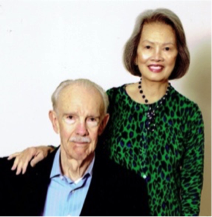 Jim Bullington continued his career with assignments in Thailand, Burma, and francophone Africa. He was Ambassador to Burundi and Dean of the Senior Seminar. After retirement, he was Peace Corps Director in Niger and special envoy in Senegal with the Bureau of Conflict and Stabilization Operations. His 2017 memoir is Global Adventures on Less-Traveled Roads. He and Tuy-Cam currently live in Williamsburg, VA.
Jim Bullington continued his career with assignments in Thailand, Burma, and francophone Africa. He was Ambassador to Burundi and Dean of the Senior Seminar. After retirement, he was Peace Corps Director in Niger and special envoy in Senegal with the Bureau of Conflict and Stabilization Operations. His 2017 memoir is Global Adventures on Less-Traveled Roads. He and Tuy-Cam currently live in Williamsburg, VA.

